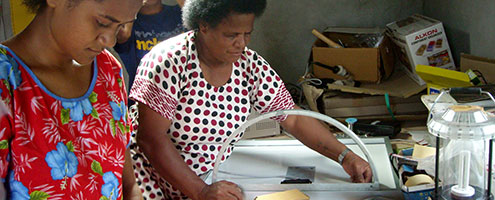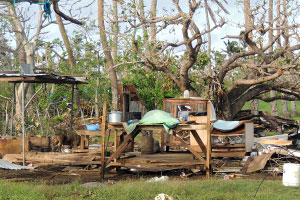Putting women at the forefront of climate change and disaster response in the Pacific
Whether training women solar engineers in Fiji or assisting with the humanitarian response plan after a major cyclone in Tonga, UN Women is working with climate-change and disaster-management professionals across the Pacific.Date:

Reapi Waitaleca is a grandmother in the village of Nabouwalu on the Fijian island of Kadavu. She is also a trained solar engineer who has installed solar panels for all the households in her village and established a solar workshop. She is now training an 18-year-old high school graduate as an apprentice engineer.
“On Saturday, I was busy with washing so I asked her [trained young woman] to fix the charge controller in the communal hall and she fixed it,” beams Reapi.
Reapi is one of 10 Fijian women who have installed solar panels for 376 households in 12 villages around Fiji after participating in the “Rural Women Light up the Pacific” programme that included six months of training in India. The programme sees UN Women working with the Barefoot College to give women a source of income and more influence within their villages, providing examples that can inspire other women and girls to look beyond traditional gender roles.
In this way, solar electricity becomes much more than an environmentally-friendly energy source. For many remote Pacific communities without access to their national grids, it also represents an effective energy solution that can spur progress in poverty reduction, gender equality, education and health.
As a collection of small, isolated and low-lying island nations, the Pacific region is among the first to feel the effects of climate change – from extreme weather events to other forms of ecological damage such as rising soil and water salinity. Most Pacific Island countries and territories are already experiencing these climate-related hazards.
Studies estimate that 18 million people have been affected by weather-related disasters in the Pacific Islands, up from 1.2 million in the 1980s [1]. According to the UN’s International Fund for Agricultural Development (IFAD), a 2 per cent temperature rise could increase the intensity of tropical cyclones in the northwest Pacific by 12 to 15 per cent [2].
Pacific women have essential skills and knowledge regarding clean water sources, food preparation, agriculture and livelihoods; however, they are often excluded from the decision-making processes around climate change adaptation and mitigation, as well as disaster risk-management.
They also face a number of secondary, intangible impacts in the aftermath of disasters. Often rooted in existing gender inequalities, these impacts can include increased rates of gender-based or sexual violence, unequal access to humanitarian assistance, loss of economic opportunities and an increased workload. After two tropical cyclones hit Tafe Province in Vanuatu in 2011, the Tanna Women’s Counselling Centre reported a 300 per cent increase in new domestic violence cases [3].
UN Women provides training, support and resources to climate-change and disaster-management professionals in the Pacific in order to help them take the differing needs of women and men into account.
One of these resources is the Pacific Gender and Climate Change Toolkit. The toolkit focuses on food security, water, energy and disaster-risk-reduction and was developed to help dispel myths around gender. It is aimed at climate change professionals working in national governments, non-governmental organizations, as well as regional and international organizations.
The toolkit is the result of collaboration between UN Women, the Secretariat of the Pacific Community, the German Federal Enterprise for International Cooperation (GIZ), the Secretariat of the Pacific Regional Environmental Programme and UNDP. An accompanying training programme is now underway.

UN Women staff was also on the ground in the immediate aftermath of several recent disasters in the region. Tropical Cyclone Ian, which hit Ha’apai on 11 January, 2014, was the biggest storm ever recorded in Tonga. When the clouds cleared, around 5,000 of Ha’apai’s 6,100 people had been directly affected, leaving 3,500 homeless.
Tonga’s Government requested UN Women’s assistance in supporting the national authorities’ efforts to disaggregate data on the affected population, by sex and age, although the organization also provided support to help ensure that both the Humanitarian Action Plan and protection assessment were gender-sensitive.
“The assistance we provided has built on the strong leadership already in place,” says Pip Ross, UN Women’s Protection and Gender Advisor in Fiji, who worked with the Tongan Government. “There are real obstacles for the Tongan government to tackle in fully operationalizing global protection standards for women and girls who are affected by disasters, but I’m confident that the national Safety and Protection Cluster is moving in the right direction with this challenging task.”
For more information on Women and the Environment, check out the In Focus editorial package on the new Beijing+20 campaign website.
[1] Anderson, C L. (November 2009) “Gendered dimensions of disaster risk management, natural resource management, and climate change adaptation in the Pacific”. SPC Women in Fisheries Information Bulletin #20.
[2] IFAD, 2012. Climate Change Impacts: Pacific Islands.
[3] UN OHCHR, 2011. Protecting the Rights of Internally Displaced Persons in Natural Disasters. Challenges in the Pacific.